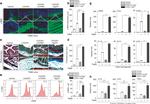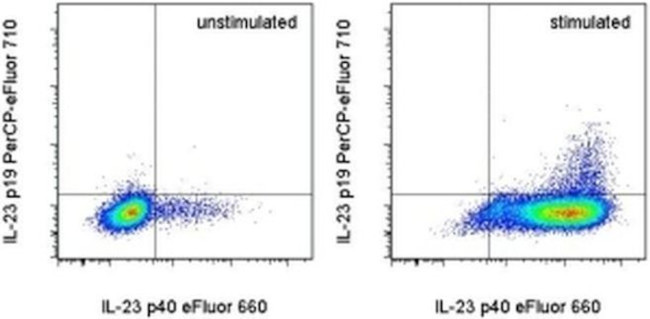Search Thermo Fisher Scientific
Invitrogen
IL-23 p19 Monoclonal Antibody (fc23cpg), PerCP-eFluor™ 710, eBioscience™
FIGURE: 1 / 2
IL-23 p19 Antibody (46-7023-82) in Flow


Product Details
46-7023-82
Species Reactivity
Published species
Host/Isotype
Recommended Isotype Control
Class
Type
Clone
Immunogen
Conjugate
Excitation/Emission Max
Form
Concentration
Purification
Storage buffer
Contains
Storage conditions
Shipping conditions
RRID
Product Specific Information
Description: This fc23cpg monoclonal antibody reacts with the p19 subunit of mouse IL-23, a heterodimeric cytokine made up of two disulfide-linked subunits, p40 and p19. It is closely related to IL-12, with which it shares the p40 subunit. IL-23 signals through a heterodimeric receptor expressed on activated T cells, macrophages, and dendritic cells. The receptor shares the IL-12Rbeta1 chain with IL-12, while the IL-23R chain is unique to the IL-23 receptor complex. Binding of IL-23 to its receptor activates Jak/STAT pathways similarly to IL-12, but the two cytokines exhibit distinct functions. Unlike IL-12, which induces T-bet and Th1 differentiation, IL-23 signaling results in RORgammat expression and supports CD4^+ T cells with the Th17 phenotype.
Dendritic cells and macrophages produce IL-23 in response to TLR2, TLR4, and TLR8 ligands, as well as agonists of the beta-glucan receptor, Dectin-1. Our studies suggest donor, kinetics and type of stimulant can result in variation in IL-23 expression levels. Recent publications suggest the p19 subunit may also exist in the absence of association with p40.
Applications Reported: This fc23cpg antibody has been reported for use in intracellular staining followed by flow cytometric analysis.
Applications Tested: This fc23cpg antibody has been tested by intracellular staining and flow cytometric analysis of stimulated mouse bone marrow-derived dendritic cells using the Intracellular Fixation & Permeabilization Buffer Set (Product # 88-8824-00) and protocol. Please refer to Best Protocols: Protocol A: Two step protocol for (cytoplasmic) intracellular proteins located under the Resources Tab online. This can be used at less than or equal to 0.125 µg per test. A test is defined as the amount (µg) of antibody that will stain a cell sample in a final volume of 100 µL. Cell number should be determined empirically but can range from 10^5 to 10^8 cells/test. It is recommended that the antibody be carefully titrated for optimal performance in the assay of interest.
PerCP-eFluor® 710 emits at 710 nm and is excited with the blue laser (488 nm); it can be used in place of PerCP-Cyanine5.5. We recommend using a 710/50 bandpass filter, however, the 695/40 bandpass filter is an acceptable alternative. Please make sure that your instrument is capable of detecting this fluorochrome.
Light sensitivity: This tandem dye is sensitive to photo-induced oxidation. Please protect this vial and stained samples from light.
Fixation: Samples can be stored in IC Fixation Buffer (Product # 00-8222) (100 µL of cell sample + 100 µL of IC Fixation Buffer) or 1-step Fix/Lyse Solution (Product # 00-5333) for up to 3 days in the dark at 4°C with minimal impact on brightness and FRET efficiency/compensation. Some generalizations regarding fluorophore performance after fixation can be made, but clone specific performance should be determined empirically.
Excitation: 488 nm; Emission: 710 nm; Laser: Blue Laser.
Filtration: 0.2 µm post-manufacturing filtered.
Target Information
IL-23 is a heterodimeric cytokine composed of the p40 subunit of IL-12 disulfide-linked with a protein p19. p19, like p35 of IL-12, is biologically inactive by itself. IL-23 interacts with IL-12Rbeta1 and an additional, novel beta2-like receptor subunit with STAT4 binding domain, termed IL-23R. IL-23 is secreted by activated mouse and human dendritic cells. Biological activities of mouse IL-23 are distinct from those of mouse IL-12. Mouse IL-23 was found not to induce significant amounts of IFN-γ. Mouse IL-23 does induce strong proliferation of memory T cells (but not naive T cells), whereas IL-12 has no effect on memory cells. Additionally, mouse IL-23 (but not IL-12) can activate mouse memory T cells to produce the proinflammatory cytokine IL-17. Human IL-23 has biological properties which are less distinct from human IL-12; human IL-23 induces proliferation of memory T cells and induces moderate levels of IFN-γ production by naive and memory T cells, as compared to IL-12.
For Research Use Only. Not for use in diagnostic procedures. Not for resale without express authorization.
How to use the Panel Builder
Watch the video to learn how to use the Invitrogen Flow Cytometry Panel Builder to build your next flow cytometry panel in 5 easy steps.
Bioinformatics
Protein Aliases: il 23; IL 23 A; Il-12b; Il-12p40; IL-23 subunit alpha; IL-23-A; IL-23p19; IL12B; Il12p40; il23; ILN; Interleukin; interleukin 12B; Interleukin-23 subunit alpha; Interleukin-23 subunit p19; MGC79388; RP23-388G23.1
Gene Aliases: IL-23; Il23a; p19
UniProt ID: (Mouse) Q9EQ14
Entrez Gene ID: (Mouse) 83430

Performance Guarantee
If an Invitrogen™ antibody doesn't perform as described on our website or datasheet,we'll replace the product at no cost to you, or provide you with a credit for a future purchase.*
Learn more
We're here to help
Get expert recommendations for common problems or connect directly with an on staff expert for technical assistance related to applications, equipment and general product use.
Contact tech support

